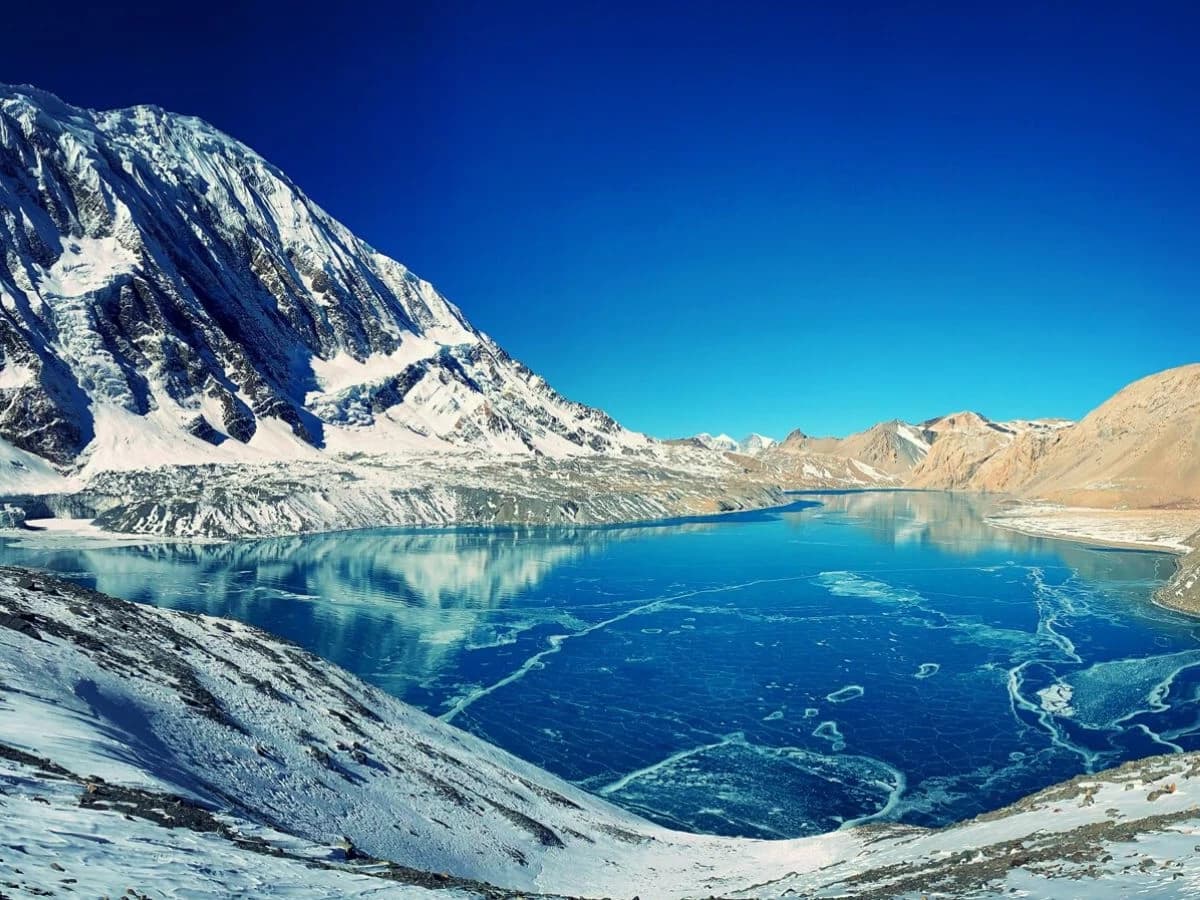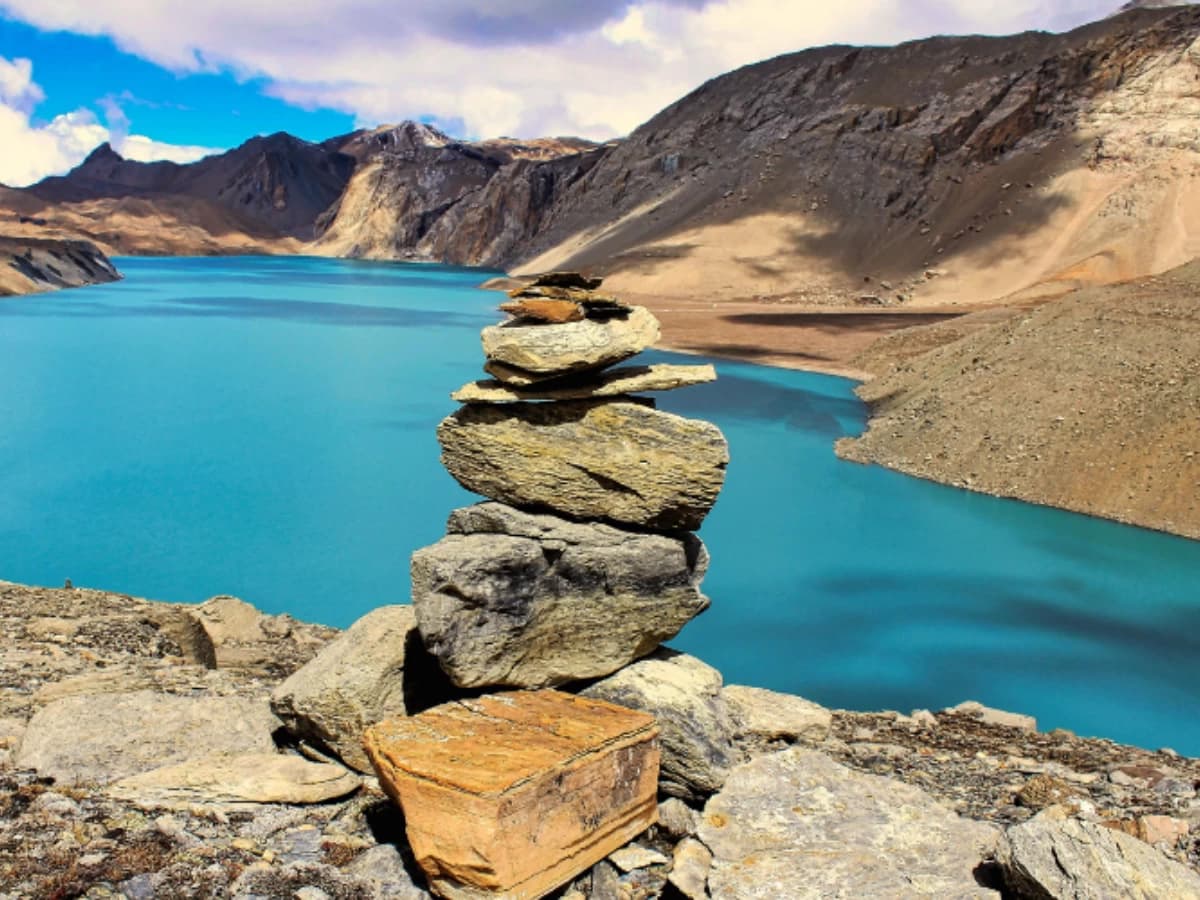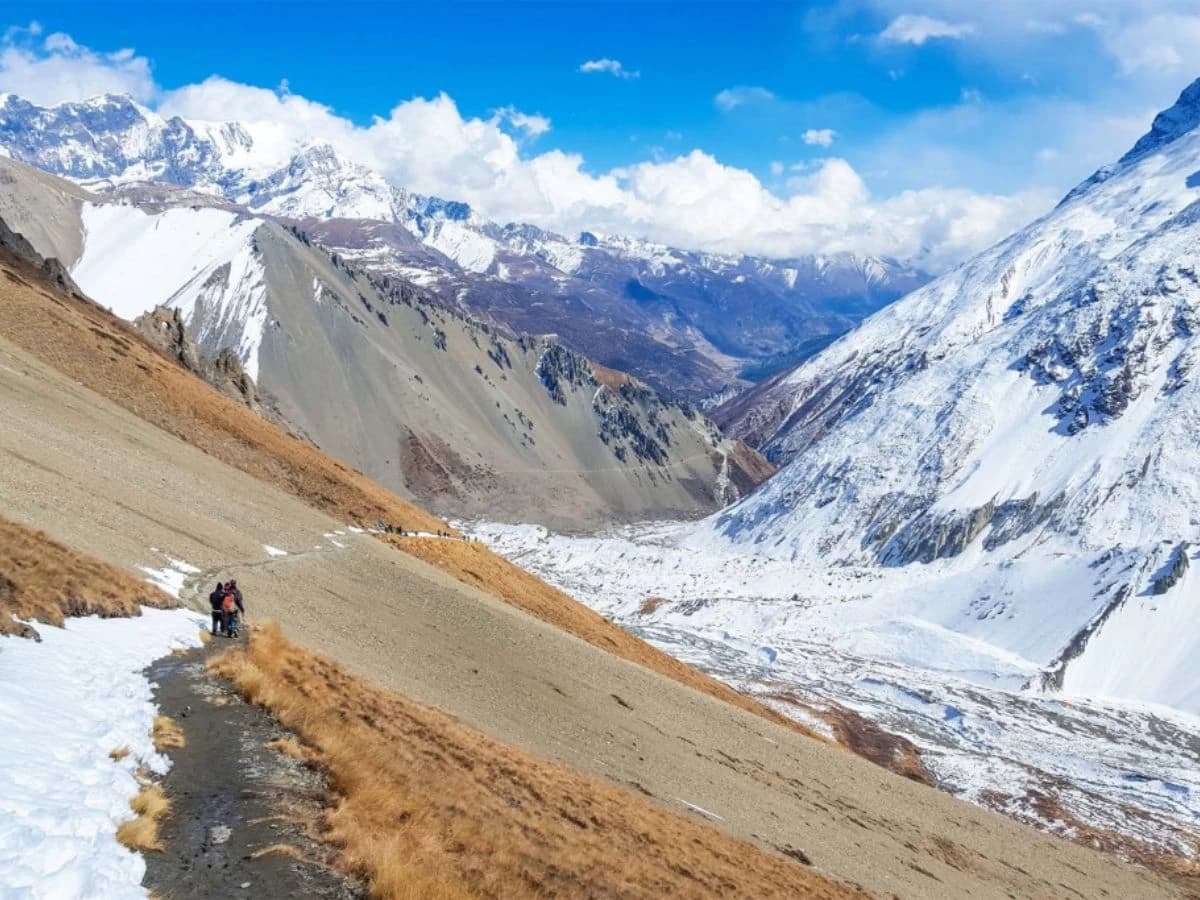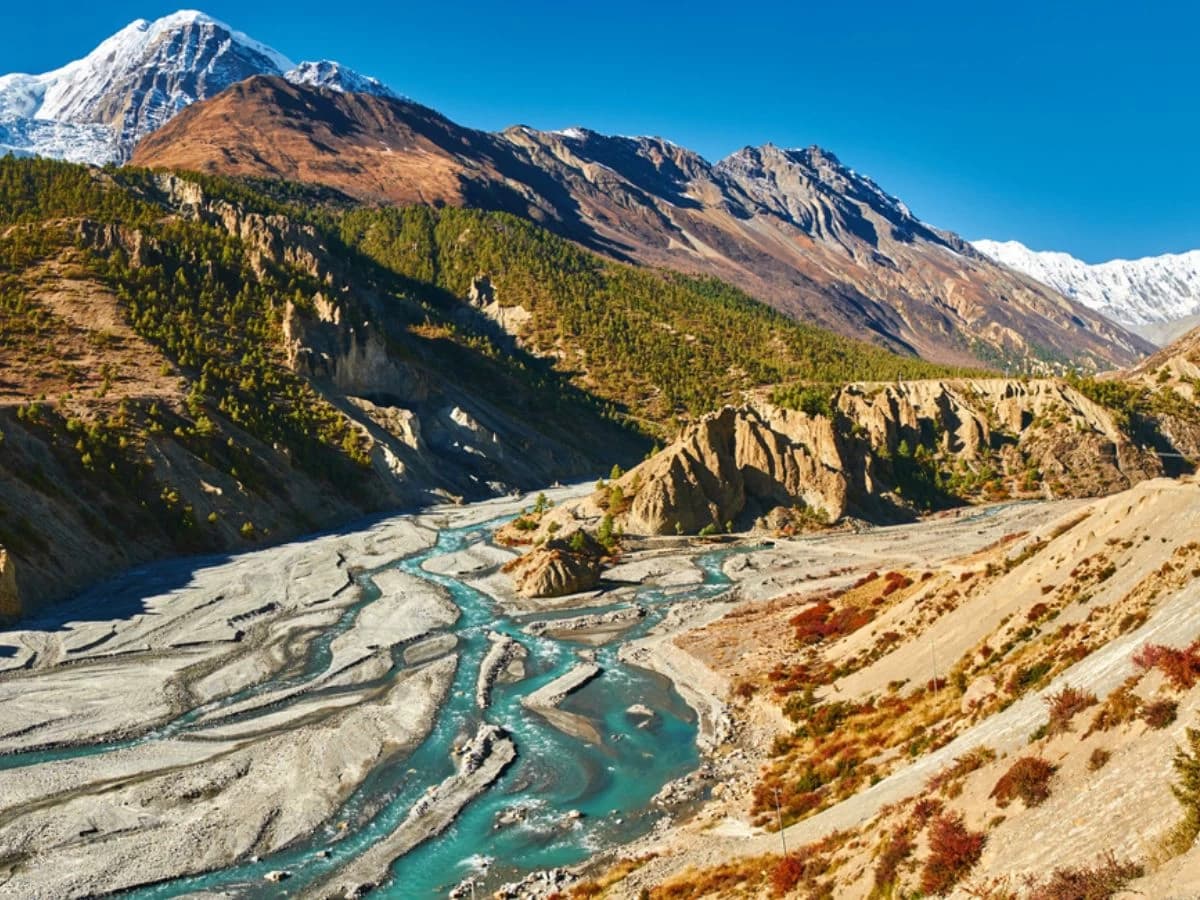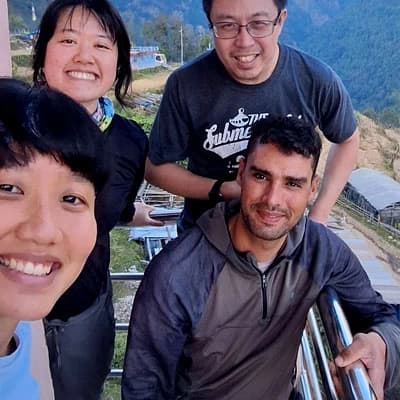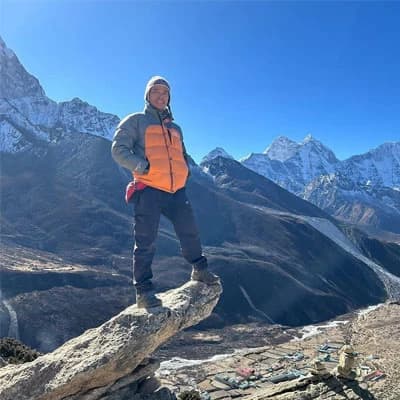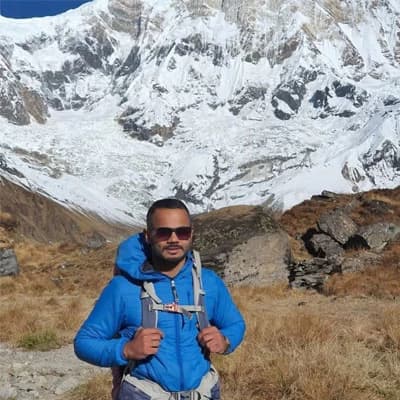The Tilicho Lake Trek is an amazing adventure in Nepal's Annapurna region through changing landscapes, from green valleys to rugged mountain peaks. You’ll also visit Tilicho Lake, one of the world’s highest lakes, and cross the Thorong-La Pass with incredible Himalayan views. Along the way, you’ll explore traditional villages, visit ancient monasteries, and experience local culture. With comfortable travel options like scenic drives and a short flight, this trek is a great choice for those seeking a challenging yet rewarding journey.
Tilicho Lake Trek
Highlights: Tilicho Lake Trek
- Visit Tilicho Lake, one of the highest lakes in the world, surrounded by exquisite mountains.
- Cross the famous Thorong La Pass at 5,416 meters for astonishing views of surrounding peaks.
- Enjoy incredible views of Annapurna, Dhaulagiri, Nilgiri, and other majestic peaks.
- Discover the traditions and lifestyle of the Magar, Gurung, and Thakali communities.
- Visit the sacred site of Muktinath significant to both Hindus and Buddhists.
- Explore the fascinating Manang Valley and its unique culture and way of life.
- Walk through beautiful forests of rhododendrons, oaks, and lush valleys with stunning mountain backdrops.
- Visit the largest and most important Bhraga monastery in the Manang region.
- Relax in the natural hot springs at Tatopani along the trek, which are perfect for unwinding after a long day.
Overview
The Tilicho Lake Trek is an exciting 14-day adventure that takes you deep into the Annapurna region of Nepal. You'll experience a mix of astonishing scenery, cultural encounters, and the thrill of high-altitude trekking.
The journey begins with a scenic drive to Dharapani, where you'll start trekking through charming villages, green forests, and awe-striking mountain landscapes. As you approach the iconic Tilicho Lake, one of the highest lakes in the world, the scenery dramatically changes. You'll move from green valleys and dense forests to rocky trails and barren landscapes.
A highlight of the trek is the challenging ascent over the Thorong-La Pass, which rewards you with spectacular views of the Himalayas. Along the way, you'll visit fascinating places like Manang and Muktinath, where you can experience local culture, explore ancient monasteries, and appreciate the diverse traditions of the region.
To ensure a safe and enjoyable experience at high altitudes, the itinerary includes optional acclimatization hikes and rest days. The trek concludes with a drive to Jomsom and a short flight to Pokhara, giving you time to relax and reflect on your unforgettable journey through one of Nepal's most awe-inspiring trekking routes.
Trekking to Tilicho Lake and Tilicho Base Camp
This trek is a remarkable journey in the Annapurna region of Nepal, culminating in reaching Tilicho Lake, one of the highest lakes in the world. Situated at an altitude of 4,919 meters, the lake offers incredible views of the surrounding snow-capped mountains and rugged terrain.
The trail to Tilicho Base Camp takes you through a diverse range of landscapes, starting with lush green valleys and gradually transitioning to the barren, high-altitude terrain. While the trek presents some challenges, the rewards are truly exceptional. Witnessing the mesmerizing turquoise waters of Tilicho Lake against a backdrop of majestic peaks is an unforgettable experience.
Along the way, you'll encounter charming villages inhabited by the friendly Gurung, Magar, and Thakali communities. You can explore ancient monasteries, taste local delicacies, and gain insights into their unique traditions and way of life. These cultural encounters enrich the trekking experience and provide a deeper understanding of the region.
Whether you're an experienced trekker or simply a nature lover seeking a unique adventure, the trek to Tilicho Lake and Tilicho Base Camp offers a rewarding journey that will leave you with lasting memories.
Tilicho Lake Trek Itinerary
On Day 1, your journey begins early in the morning after a filling breakfast. The drive from Kathmandu to Dharapani takes about 9-10 hours, following the Kathmandu-Pokhara Highway until Dumre. At Dumre, the route diverts toward Besisahar, the administrative center of Lamjung district.
After reaching Besisahar, you’ll take a jeep to Dharapani. On the way, you’ll enjoy gorgeous mountain scenes and the green scenery surrounding the route. As you arrive in Dharapani, you’ll get to relax and spend the night resting for the adventures ahead.
Today after breakfast, you’ll begin your trek officially from Dharapani toward Chame. The trail takes you through serene forests of pine, oak, and maple, leading to an amazing village of Danaque, known for its apple orchards. Moving ahead, you’ll cross a small wooden bridge and climb the winding trail to Timang, a village located at the base of Lamjung Himal.
From Timang, the path becomes relatively flat as you head towards Chame, the administrative hub of the Manang district. This sub-alpine town provides magnificent views of Lamjung Himal and Annapurna II. Once you arrive in Chame, you’ll get to rest, take in the scenery, and relax for the night at a cozy teahouse.
Your third day of the trek begins early as you leave Chame while enjoying a beautiful sunrise above the Lamjung Himal. The road leads you through pretty oak and pine forests, offering glorious scenes of the Annapurna Range, Pisang Peak, and the surrounding mountains. As you continue your hike, you’ll pass carved mani stones and peaceful villages, while forgetting yourself in the tranquil mountain environment.
Next up, the trail takes you along a steep, rocky path to Bhratang before opening into a breathtaking valley with more awe-inspiring views of gorgeous peaks. Plus, as you approach the Upper Pisang, you’ll notice colorful prayer flags and finely carved stones, adding spiritual value to the journey. After trekking for 6 to 7 hours, you’ll reach Upper Pisang, where you can enjoy a warm dinner while resting and spending the night at a welcoming teahouse.
On Day 4, you will begin your trek to Manang Valley by climbing a steep trail that offers you an amazing view of Tilicho Peak (7145 m) and the Manang Valley. As you continue along the ridge, the trail gradually descends toward Hungde, where you’ll pass by the landing site. From there, the path evens out, offering a comfortable walk through a flat area with graceful views of the northeast face of Annapurna III. The road then leads you into the scenic Sabje Khola Valley, where the scenery shifts to rocky terrains and meadows.
Moving on, you will cross a wooden bridge over the Marsyangdi Khola and reach Mungji village. From there, the path climbs uphill to Manang Valley, offering elegant views of Annapurna IV (7525 m). Along the way, you’ll also pass through Braga, where you can see an ancient monastery. By evening, you’ll arrive in Manang where you can relax and rest for the night.
Today is a rest day in Manang to help your body adjust to the altitude. You’ll relax and enjoy the splendid views of enchanting landscapes, towering silvery mountains, and peaceful Chortens and Monasteries scattered around the area. Plus, this is a great opportunity to explore the unique culture and lifestyle of the local people.
If you feel like being more active, you can also take a short acclimatization hike to Khangshar, which takes about 2 to 3 hours. Afterward, you’ll return to your lodge to relax and rest for the night, preparing for the next day’s journey.
Your trek begins as you leave Manang and climb toward Siri Kharka while crossing the 4000m elevation mark. The trail winds through rocky terrain snuggled between towering hills, offering a sense of adventure. As you ascend, the vegetation becomes scarce due to the cooler temperatures and stronger winds, creating a dramatic difference from the lush landscapes of earlier days.
Furthermore, you’ll cross a river on a suspension bridge to reach the settlement of Khangshar. From here, the trail leads you toward Siri Kharka, passing a serene monastery along the way. The journey rewards you with spectacular views of the Gungang and Chuli mountain ranges. Once you arrive in Siri Kharka, you can rest, and enjoy the alluring surroundings.
On Day 7, you’ll leave Siri Kharka and make your way to Tilicho Base Camp. The trail starts with a descent to a river, where you’ll cross a suspension bridge before climbing again. The path is rocky and winds through hills, offering gorgeous views of the surrounding area.
As you continue, you’ll pass the small village of Khangshar and then trek through an area with little vegetation due to the cold and high altitude. Though the trail can be challenging, the beautiful scenery and peaceful atmosphere make it all worth it. Upon reaching Tilicho Base Camp, you can relax and prepare for the next day's adventure.
After breakfast, you’ll start early from Tilicho Base Camp to avoid the afternoon winds. The trail is steep, so it will take about two to three hours of effort to reach Tilicho Lake, one of the highest lakes in the world. As you walk, you might see yaks grazing nearby.
Once you reach Tilicho Lake, you’ll be rewarded with exquisite views. The lake, surrounded by the Tilicho Himal, Annapurna Range, and Nilgiri Himal, is known for its striking turquoise waters. It is also a significant spot in Hinduism, mentioned in The Ramayan. After spending some time soaking in the beauty, you’ll return to Siri Kharka for the night.
Today, you’ll head back from Siri Kharka to Yak Kharka, following the same path. Along the way, you’ll pass through the peaceful Tare Gumba, a monastery over a thousand years old. After crossing Tare Gumba, you’ll continue to Khangsar Village.
From Khangsar, you’ll cross a seasonal bridge and climb up to a flat area. A short distance from there, you’ll arrive at Yak Kharka, where you can rest and enjoy dinner at a cozy teahouse. The views of the Annapurna mountain range from Yak Kharka are breathtaking, making it a perfect spot to relax for the night.
After breakfast, you will continue your trek, passing through Ledar, the last settlement on the trail. As you climb, you’ll reach a ridge with an amazing view of Tobuche, and Chuli Peak. The path then descends to the Marsyangdi River, where you'll cross a wooden bridge.
As you continue, the trail gradually ascends along the river’s bank and follows the winding trail to Thorong Phedi. Once you arrive, you can either relax in the teahouse for an overnight stay. Throughout the day, you’ll enjoy jaw-dropping views of snow-capped peaks and peaceful valleys.
On this day, you’ll reach the highest point of your journey, the Thorong-La Pass. The path to the Pass is rocky and challenging, requiring a steady climb. However, the effort will be worth it, as you will be rewarded with incredible views of the surrounding peaks, including Thorong Peak, the Annapurna Range, Dhaulagiri, and Nilgiri. From here, you can also see the Kaligandaki River Valley and Mustang Hills stretching below.
After taking in the spectacular views, you will begin your descent toward Muktinath, a sacred pilgrimage site for both Hindus and Buddhists. The path is easier now, following the Jhong Khola River. Upon reaching Muktinath, you will visit the famous temple and explore its rich cultural, historical, and religious importance. This is a meaningful stop on your trek, offering both spiritual and scenic rewards.
After leaving Muktinath, you will begin your drive toward Kaligandaki Gorge, passing through beautiful villages like Jharkot and Khingar. These settlements showcase strong cultural and architectural influences from Tibet.
The drive continues as you descend, bringing you to Marpha village, a great stop along the way. Finally, you will reach Jomsom, where you can enjoy yet another awe-inspiring view of the surrounding mountains, including Dhaulagiri and Nilgiri. This scenic journey provides a great opportunity to relax and appreciate the beauty of the region.
After completing your Tilicho Base Camp Trek, you will take a short flight from Jomsom to Pokhara. The 20-minute flight offers a stunning aerial view of the region, allowing you to appreciate the beauty of the landscapes from above.
Upon arrival in Pokhara, you will check into a comfortable 3-star hotel. You’ll then take time to relax and enjoy various activities in this vibrant city, such as boating, exploring the streets, shopping, and more. You can also visit notable attractions like Bat and Mahendra caves, and unwind at local eateries, bars, or cafes. It's a great way to end your trek and recharge.
On day 14, after a hearty breakfast, you’ll begin your drive back to Kathmandu. The 7-hour journey takes you through splendid villages such as Damauli, Dumre, Mugling, and Kurintar, allowing you to enjoy scenic views along the way.
Once in Kathmandu, you can choose to relax or explore Thamel's lively streets, where you can shop for more souvenirs. If you're feeling tired, you can visit a local spa for a massage. In the evening, we will gather for a farewell dinner, where you can enjoy traditional Nepali dishes along with cultural dance performances while celebrating the memories of your trek.
Tilicho Lake Trek Route Map


Cost Details
Meals:
- 3 standard meals a day during the trek
- Set of breakfast, Lunch and Dinner
Accommodation:
- 12 nights Lodge accommodation (Private room and common bathroom)
- 1 night 3 star hotel accommodation in Pokhara
Transportation:
- Shared transport from Kathmandu to Dharapani
- Drive/flight from Jomsom to Pokhara
- Tourist bus transport from Pokhara to Kathmandu
Permit:
- All the necessary permits for the trek
Guide and porters:
- An experienced English-speaking guide
- Strong porters sharing between two members
Trekking Gears:
- Sleeping bag and down jacket to use for the trek
- HMT T-shirt and Duffel bag for free
- First aid medical kit
Miscellaneous:
- Salary, food and accommodation for guide and porters
- Government taxes and liabilities
- Hot and cold beverage
- Meals in Kathmandu and Pokhara
- Accommodation in Kathmandu
- Phone calls, internet, hot shower and laundry bills
- Travel insurance and Nepal visa fee
- Trekking gears
- Tip and for guide and porters
To confirm your payment, a deposit payment is required, which is 30% of the total booking price. This deposit helps us secure permits, logistics, and other necessary arrangements for your trek.
We understand that plans can change, and we strive to be as flexible as possible. However, to cover operational costs, a cancellation fee applies. This is a percentage of your total booking price and is deducted from the deposit payment.
Cancellation Fees
Cancel 30% days before departure: 5% of the trip cost
Cancel between 10 to 30 days before departure: 10% of the trip cost
Cancel within 10 days of departure: 20% of the trip cost
If you need to cancel, please notify us as early as possible to reduce charges.
Rescheduling
Unexpected circumstances can disrupt travel plans, even if you still want to do the trip. To support our clients, we have generously waived all rescheduling fees. You can postpone and reschedule your trip at no additional cost, as long as the new departure date falls within one year of your original booking.
Upgrades
If you wish to upgrade your accommodation, transportation, or any other services not mentioned in the Trip Includes section, please be aware that these upgrades will incur additional costs. We can assist in arranging these options for you based on your preferences and availability.
Dates & Availability
Private TripIf you don't find an appropriate date, you can propose a Preferred Departure Date, and we’ll ensure the trip runs as scheduled just for you.
Trip Gallery
.webp&w=1200&q=75&dpl=dpl_5no2mbdoNHZofbQzNp4xwNy1a21g)

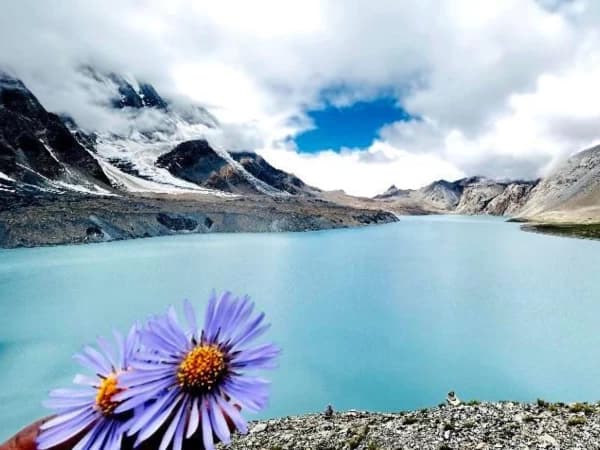
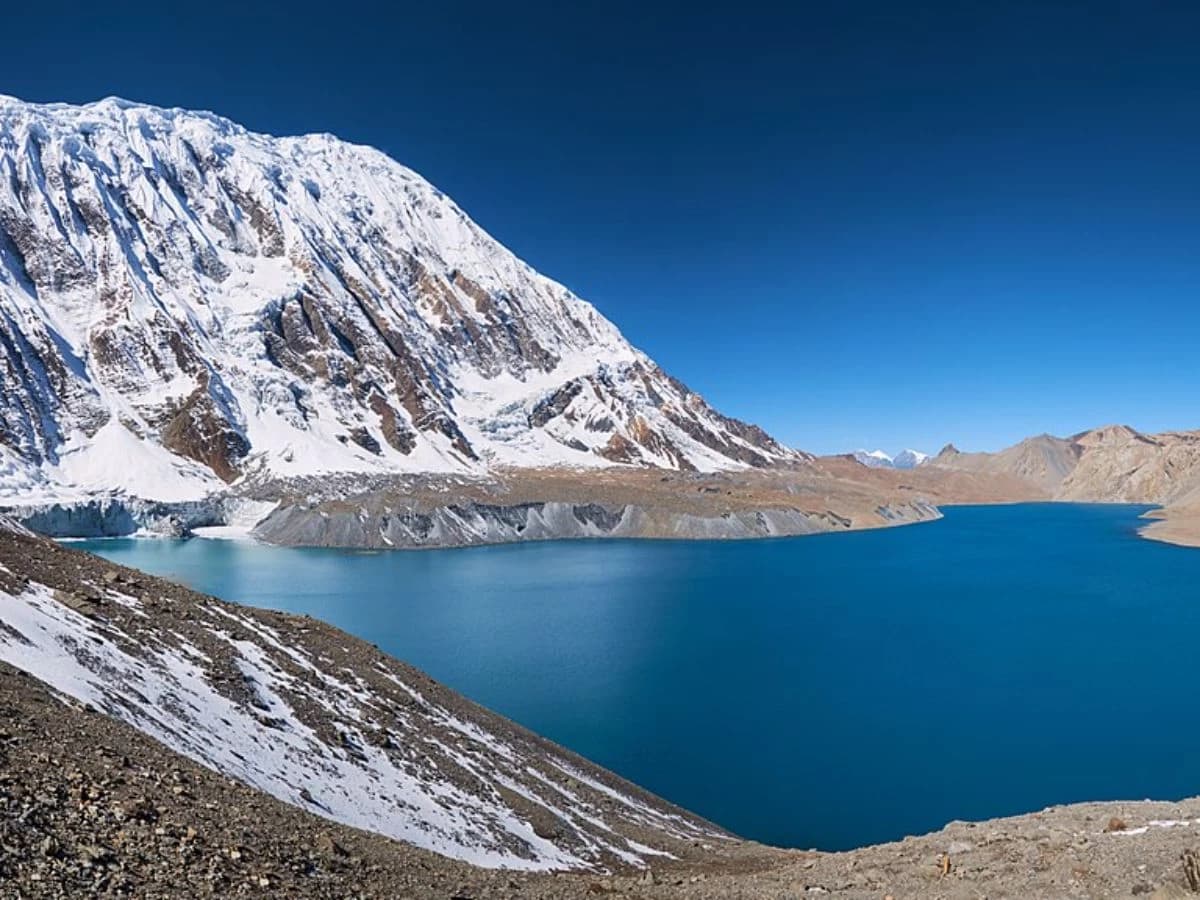
Essential Information
Food and Meals on the Tilicho Lake and Base Camp Trek
The Tilicho Lake Base Camp Trek is a wonderful adventure, and you'll want to keep your energy up with tasty food! Along the way, you’ll find many delicious options to enjoy.
Breakfast Time!
Every day on trek, you’ll start your day with a tasty breakfast! You can have scrambled eggs, pancakes, or toast with jam. If you'd like something else, you can even try Tibetan bread, warm porridge, or crunchy muesli. You can also enjoy a cup of tea, coffee, or hot chocolate to kickstart your day.
Lunch and Dinner Delights
For lunch and dinner, you'll have many yummy choices! You can enjoy a bowl of soup, like tomato, vegetable, or garlic soup. If you want something traditional, try dal bhat - a special dish with rice, lentils, and veggies.
If you’re in the mood for noodles, you’ll find many kinds, like vegetable noodles or fried noodles. You can also try momos, which are delicious dumplings filled with veggies or meat.
For something familiar, you can even find pizza and other Western foods along the trek.
Tips to Tackle High Altitude
- While trekking at high altitudes, it’s important to stay healthy and hydrated. Drink plenty of fluids: Water, green tea, lemon tea, and ginger tea are all great options. Eat fresh fruits and veggies: These help keep you strong with important vitamins and minerals.
- Avoid too much dairy: Milk and cheese may upset your stomach at high altitudes.
- Skip alcohol and caffeine: These can dehydrate you and make you feel sick.
Accommodation on the Tilicho Lake Trek
Before your exciting Tilicho Lake Trek, you'll stay in a comfortable hotel in Kathmandu. Similarly, after your adventure, you'll enjoy a relaxing stay in a hotel in Pokhara.
However, during your trek, you'll be staying in teahouses, which are like simple guesthouses. Imagine cozy rooms with two beds, blankets, and maybe even a small table and chairs. At higher altitudes, the rooms might be more basic, but you'll always have a warm place to rest your head.
Additionally, most teahouses have a big dining room with a warm fire. It's a great place to relax after a day of hiking, chat with other trekkers, and enjoy a delicious meal.
Important Tip: Remember to bring some toilet paper with you! While some teahouses have modern toilets, many have simple long-drop toilets.
Drinking Water on the Tilicho Base Camp Trek Route
Drinking plenty of water is very important when you're trekking at high altitudes. Your body needs extra water to stay hydrated and keep you feeling strong. You can carry a reusable water bottle and refill it at teahouses along the way.
You can also buy boiled water from the teahouses, or use water purification tablets to treat the water from streams. It's best to avoid drinking water directly from rivers or taps, as it may not be safe.
Besides water, you'll find lots of delicious drinks at the teahouses. Warm drinks like tea and coffee are perfect for warming you up on chilly mornings or after a long day of hiking. You can try different types of tea, such as black tea, herbal tea, or masala tea.
Remember: It's best to avoid drinking alcohol, especially at high altitudes. Alcohol can dehydrate you and make it harder for your body to adjust to the altitude.
Essential Packing List for Your Tilicho Lake Trek
Packing for your trek to Tilicho Lake is an exciting part of the adventure! Besides warm clothes and sturdy trekking shoes, there are a few essential items you shouldn’t forget.
Stay warm and protected: Bring a windcheater, sunglasses, gloves, and waterproof pants to protect yourself from the wind, rain, cold, and snow.
Stay entertained: Pack a book, pocket games, and a flashlight for your evenings in the teahouses.
Stay safe and healthy: Carry extra camera batteries, a power bank, and medical supplies like band-aids, pain relievers, and water purification tablets.
With these items, you’ll be well-prepared for your amazing journey to Tilicho Lake!
Trek to Tilicho Base Camp Difficulty Level
The Trek to Tilicho Base Camp is an adventure, but it's also challenging. Most of the trek takes place above 3,000 meters, which means the air is thinner and it can be harder to breathe. You'll also be walking on steep and rocky trails, which can be tough on your legs and feet.
Even though it's challenging, the rewards are amazing! You'll see incredible mountain views and experience something truly special.
To prepare for the trek, you need to get ready both physically and mentally. The high altitude and difficult terrain can be demanding. But with the right preparation, the trek to Tilicho Base Camp will be an unforgettable experience!
Travel Insurance for Tilicho Lake and Base Camp Trek
When planning your trek to Tilicho Lake and Base Camp, it’s important to have travel insurance. Since you’ll be trekking at high altitudes, there’s always a chance of getting sick or injured. Medical emergencies and evacuations can be very expensive, so make sure your insurance covers these situations.
Before buying insurance, check that your plan covers all the activities you’ll be doing, like hiking and mountain climbing. Make sure the policy includes coverage for high-altitude trekking and evacuation services up to the altitude you’ll be reaching, especially if you go above 5,000 meters (16,404 feet).
Some policies also offer 24/7 emergency assistance, which can be really helpful when you’re in remote areas with limited communication. Finally, check if your insurance covers trip cancellations, as trek deposits are usually non-refundable.
Best Time to Undertake Tilicho Base Camp Trek in Nepal
The best time to trek to Tilicho Base Camp in Nepal is during the spring (March to May) and autumn (September to November).
Peak Seasons:
a. Spring: The weather in spring is warm and pleasant, making it a favorite time for the trek. The trails are colorful with blooming rhododendrons, and the mountain views are breathtaking. Daytime temperatures are comfortable, though it can get chilly at night.
b. Autumn: Autumn is another great season for the trek, with clear skies and perfect weather. The views of the Himalayas are stunning, and the trails are lively as many trekkers explore this beautiful region.
Other Seasons:
a. Summer: Summer brings monsoon rains, making the trails slippery and the weather unpredictable. If you’re prepared with rain gear and don’t mind some challenges, it can still be a unique adventure.
b. Winter: Winter is cold with snow-covered trails, which can make trekking tough. It’s best for experienced trekkers who enjoy quieter paths and are ready for cold conditions.
By choosing the right season, your trek to Tilicho Base Camp will be an unforgettable experience filled with attractive views and comfortable weather.
Tilicho Lake Trek Equipment List
FAQs
The Tilicho Lake Base Camp Trek is part of the Annapurna Circuit Trek. If you're already doing the Annapurna Circuit, you can visit Tilicho Lake by adding 3-4 extra days to your trek. The trail splits at Manang and joins the main circuit again at Yak Kharka, allowing you to enjoy both Tilicho Lake and the Annapurna Circuit in one trip.
It is not safe to hike alone in the Annapurna region, including the Tilicho Base Camp Trek. If you get lost or take the wrong path, there might not be anyone to help you. Hiking alone can be dangerous. It's best to have a qualified trek guide with you who knows the route and can keep you safe throughout the journey.
There are several ways to reach Tilicho Lake, including by helicopter, trekking, a combination of trekking and jeep drive, motorbike ride to Shirikharka, or mountain biking. The most popular method is trekking.
People often take a bus to Besishahar and then use a jeep to reach the starting point of the Tilicho Lake trail. From there, it's a 2-day hike uphill to the Tilicho Lake Base Camp. With road development, many trekkers now use a mix of these transportation methods to reach Tilicho Lake.
There are a few ways to get from Tilicho Lake to Pokhara. You can either cross Mesokanto Pass to reach Jomsom and then drive or trek to Pokhara or trek down to join the Annapurna Circuit trail, pass Thorong La, and head to Muktinath before continuing to Pokhara. The most common route is to trek down to Khangsar and take a jeep to Pokhara. If you prefer, you can also use a horse or even a helicopter to reach Pokhara.
Yes, you can do this trek! The journey starts with the Nar Phu Valley trek, and after crossing the Kang La Pass, you can continue to Tilicho Lake. After visiting Tilicho Lake, you can keep going and trek directly to Thorong La Pass as part of the Annapurna Circuit. This is a great way to experience all three beautiful places in one adventure.
Getting a Nepali visa is simple and easy. You can apply for it in your home country or directly at the Kathmandu airport. Many travelers find it easier to get a visa at the airport. For more details about the visa process, you can visit the official Nepal Immigration website.
To go on the Tilicho Lake Trek, you need two permits: the Annapurna Conservation Area Project (ACAP) permit and the Trekkers' Information Management System (TIMS) card. These permits help keep track of trekkers and protect the area.
Yes, most teahouses and lodges along the Tilicho Base Camp Trek in Nepal have charging stations. However, power outages can sometimes happen, so it’s a good idea to bring a power bank or extra batteries to keep your devices charged.
During the Tilicho Base Camp Nepal Trek, most teahouses offer Western-style flushing toilets, especially at lower altitudes. However, as you ascend, you may encounter squat toilets, typically a porcelain basin on the floor or a simple hole in the ground, usually located outside the room. It's a good idea to be prepared for these more basic toilet facilities along the trek.
During the main trekking season, the route to Tilicho Lake can get quite busy. Sometimes, teahouses may be full, so it's important to plan ahead. It's always a good idea to arrive early to secure a room. If you're traveling with Himalayan Massif Trek, we will take care of all your accommodations, so you don’t have to worry.
To avoid altitude sickness while trekking to Tilicho Base Camp, it's important to follow a few simple tips. Make sure to ascend slowly and take regular breaks to allow your body to adjust. Drink plenty of water to stay hydrated and eat a balanced diet for energy. Avoid alcohol, cigarettes, and tobacco, as they can make things worse. Finally, be prepared both physically and mentally for the trek to help your body cope with the altitude.
To do the Tilicho Lake and Base Camp Trek, you need to be in good shape. The trek has long walks, some steep climbs, and high altitudes. It helps if you have some hiking experience. Regular exercise like walking or jogging can prepare you. You don’t need to be super fit, but being in moderate shape will make the trek easier and more enjoyable.
On the Tilicho Lake trek, you can find mineral water at most teahouses, but it's not the best choice. Mineral water can be expensive and harmful to the environment because it uses a lot of plastic bottles. To stay eco-friendly, it's better to use a water purifier or purification tablets. This way, you can stay safe and help protect the beautiful mountains.
For the Tilicho Lake trek, it’s important to have the right gear to make your journey easier and more comfortable. Gear plays a key role in the success of your trek, so it's best to bring everything you need from home.
However, if you miss anything, you can find it in Kathmandu. You can also rent items like sleeping bags in Kathmandu, and Himalayan Massif Trek will assist you in renting gear without needing a deposit.
Yes, you can easily find vegetarian food during the Tilicho Lake and Base Camp Trek. Most teahouses offer vegetarian meals, and we recommend them to avoid stomach issues, especially at high altitudes. Non-vegetarian food can sometimes cause problems, so sticking to vegetarian options is safer for your health.
The best time to go on the Tilicho Lake trek is from September to November when the weather is clear and perfect for trekking. The second best time is from March to April, as the weather is also nice, and you can enjoy the beautiful views of the mountains. Both seasons offer great conditions for your adventure!
Most tea houses along the Tilicho trek provide Wi-Fi, but the connection can sometimes be weak or interrupted. Keep in mind that you may need to pay extra for Wi-Fi access at these teahouses. While it's possible to stay connected, be prepared for occasional network issues.
Tilicho Lake is about 85 meters deep on average, according to Wikipedia. However, the Government of Nepal has measured it to be more than 100 meters deep. While it’s not the deepest lake in Nepal, Tilicho Lake is the largest lake at such a high altitude, sitting at 4,919 meters above sea level.
Tilicho Lake covers an area of 4.8 square kilometers and is 1.2 meters wide. It is the largest lake located above 4,900 meters in the world.
Tilicho Lake is a sacred place in the Nepal Himalayas, and swimming there is not a good idea. The water is very cold, especially in winter when the lake freezes, making it better for ice skating. It’s best to enjoy the beautiful views and peaceful atmosphere of the lake while respecting its spiritual importance.
Knowledgeable Local Guides
Our local guides are well-trained, friendly, and respectful. They also make sure your trek is both safe and enjoyable. Their deep knowledge of the Trek to Tilicho Lake and the surrounding region ensures a meaningful journey. They share fascinating insights about the area’s culture, history, and natural beauty, making your trek even more enriching.
Accurate Service Delivery
At Himalayan Massif Trek, we deliver what we promise. We follow the itinerary closely, making sure that every service mentioned in the package is provided without compromise. Whether it’s the trek to Tilicho Base Camp or exploring the beauty of Tilicho Lake, you can trust us to make it a smooth and fulfilling experience.
Curated Itinerary
Our updated and carefully designed itinerary reflects the latest road improvements, allowing a direct drive from Kathmandu to Dharapani. This adjustment saves time, ensuring you have more opportunities to immerse yourself in the beauty of the Tilicho Lake and Base Camp Trek.
Value for Money
HMT offers competitive pricing with no hidden costs, making sure you get the most out of your trip. Our comprehensive packages cover trekking permits, accommodations, and meals. We also provide group discounts and special offers for repeat travelers, making the Tilicho Base Camp Nepal Trek both affordable and rewarding.
- Expertise in High-Altitude Trekking Adventures
- Over 18 Years of Experience in The Himalayas
- Authorized and Reliable Trekking Partner
- Trusted by Thousands of Adventurers Worldwide

The HMT team was professional and caring—thank you for an amazing experience!
The trek was tough, especially the high altitude, but the views of the lake and surrounding peaks were worth every step. Our guide Ajit was...
Coming from Singapore, I was amazed by the sheer beauty of Nepal and the Tilicho Lake Trek. The altitude was a challenge, but the stunning...
